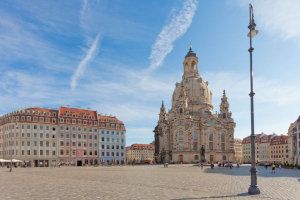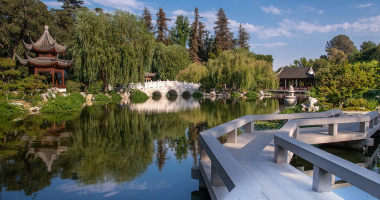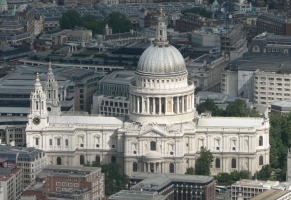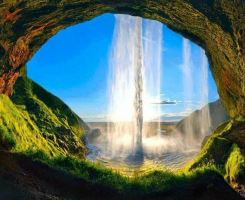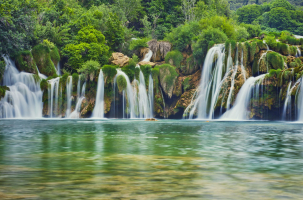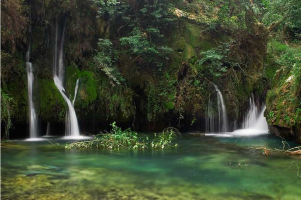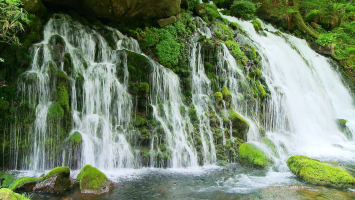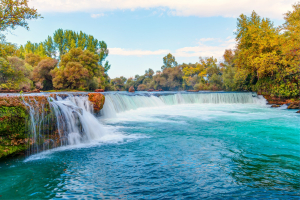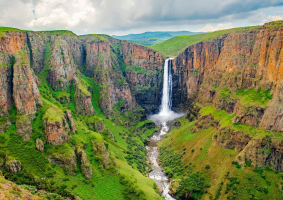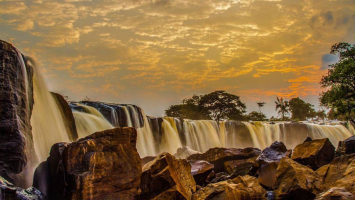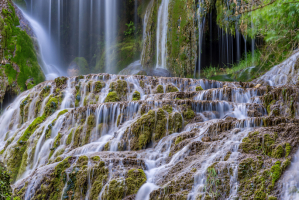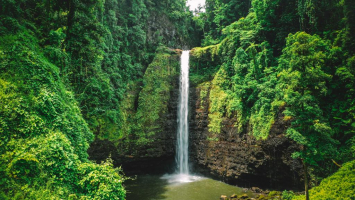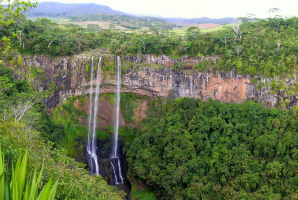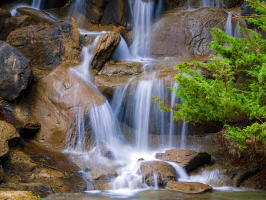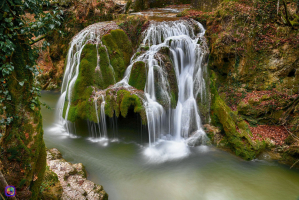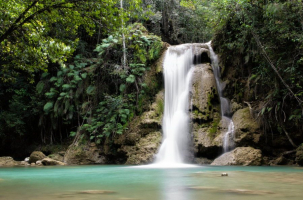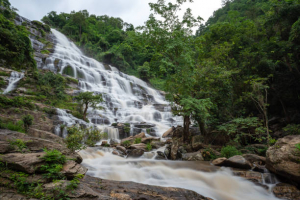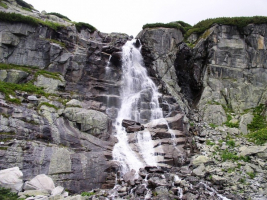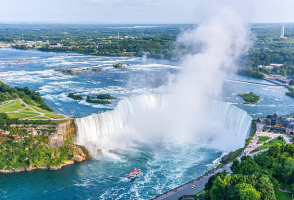Top 10 Most Magnificent Palaces
The palace is the place where the aristocratic royalty lived, so it has always been seen as a place of splendor and majesty. Famous castles are not only ... read more...associated with the history of a country with architectural value, so every year they become attractions for millions of tourists to visit. Let's take a look at the 10 palaces famous for their beauty and tourist attractions, ranked by UNESCO as a world-historical and cultural relic.
-
The Palace of Versailles has been classified as a World Heritage Site for forty years and is one of the most splendid achievements in French 17th century art. Louis XIII's old hunting pavilion was altered and expanded by his son, Louis XIV when he established the Court and government in 1682. A succession of kings continued to enhance the Palace until the French Revolution.
Today the Palace includes 2,300 rooms spread over 63,154 m2.
In 1789, Louis XVI was compelled to leave Versailles for Paris. The Palace would never be a royal residence once again and played a new role which became the Museum of the History of France in 1837 by order of King Louis-Philippe coming to the throne in 1830. The rooms of the Palace were devoted to housing new collections of paintings and sculptures, and important historic France events. These collections continued to be extended until the early 20th century. At that time, under the influence of its most prominent curator, Pierre de Nolhac, the Palace got back its historical role when the whole central part was reconstructed the original appearance as a royal residence during the Ancien Régime.
The Palace of Versailles did not play the protective role of a medieval stronghold. Starting in the Renaissance period, the term "chateau" referred to the rural location of a luxurious dwelling, in opposition to a metropolitan palace. Therefore, it was frequent to speak of the Louvre "Palais” in the heart of Paris, and the "Château” of Versailles out in the countryside. When Versailles was just a village, it was demolished in 1673 to make way for the new town Louis XIV wished to create. Now, the centerpiece of Versailles urban planning, the Palace seems to be a far cry from the rural residence it used to. However, the garden end on the west side of the Estate of Versailles is still abutted by woods and agriculture.
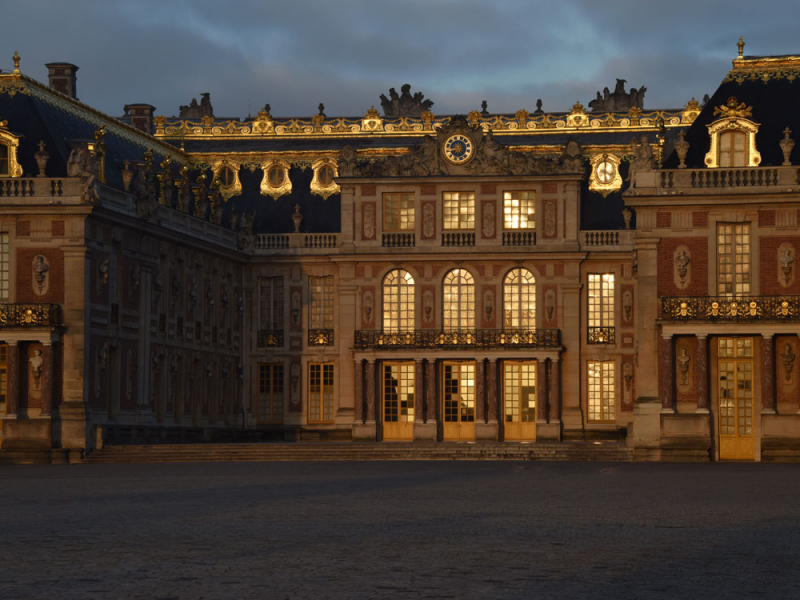
The Palace of Versailles. Photo: en.chateauversailles.fr 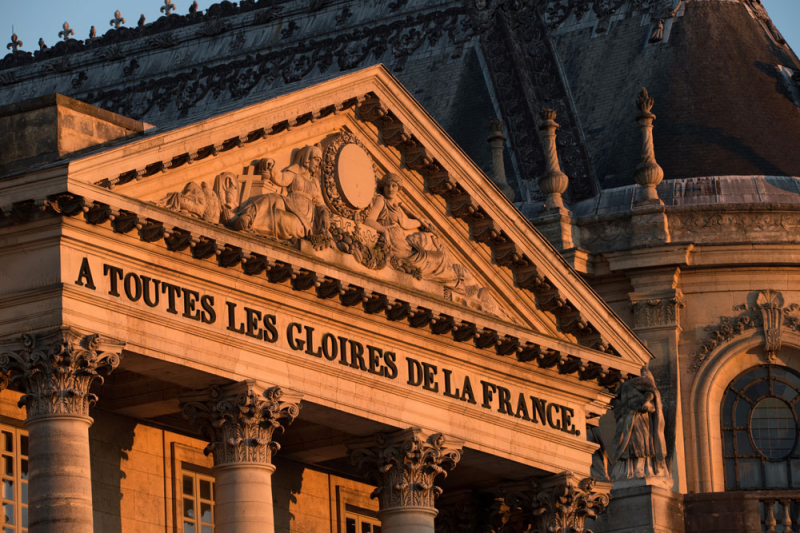
The Palace of Versailles. Photo: en.chateauversailles.fr -
Windsor Castle was built in the 11th century after the Norman invasion of England by William the Conqueror. King Edward III rebuilt the palace to become "the most expensive secular building project of the entire Middle Ages in England". Edward's core design lasted through the Tudor period, during which Henry VIII and Elizabeth I made increasing use of the castle as a royal court and center for diplomatic entertainment.
Windsor Castle, together with Buckingham Palace and Holyrood Palace, are the three official residences of the British royal family. Windsor Castle in the town of Windsor, Berkshire, England is known as the largest inhabited castle in the world. Not only became a place to rest and play, but also a place to perform national affairs, before that it was also a fortress, a place to keep the British royal family. Covering a huge area of more than 5 hectares (50,000 m2), the towering castle is surrounded by neatly trimmed green trees creating a beautiful scene like a fairy castle.
From the outside, the castle has a sturdy structure and was changed from stone to brick, iron, and steel to strengthen the sturdy construction for nearly 1000 years. The magnificent beauty of the castle still makes many visitors admire it because of not only its function but also the aesthetic beauty it brings. Each tile, tinged with time, is meticulously arranged, durable, forming solid buildings, delicately carved motifs, and feats.
Inside the famous castle is the Chapel of Saint George - the hero slaying the dragon, which witnessed royal weddings, important events of the country and is the resting place of kings and royals like the King. George III, King George IV, King George V, King George VI, King William IV, Queen Elizabeth, and Princess Margaret. The chapel was built after the castle, 14th century, a masterpiece of Gothic architecture with intricately carved stone vaulted ceilings and impressive reflective colored windows. Not only that, but this is also a place to display the sword that once belonged to King Edward III and the beast statues depicting 14 animals that have appeared on the official royal coat of arms: unicorn, bear, a white horse, lion death, dove, ...
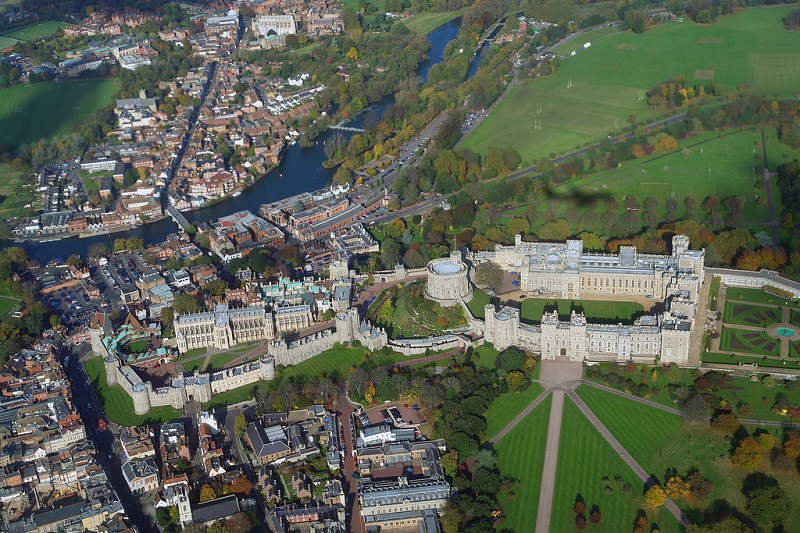
View of Windsor Castle. Photo:https: fiditour.com 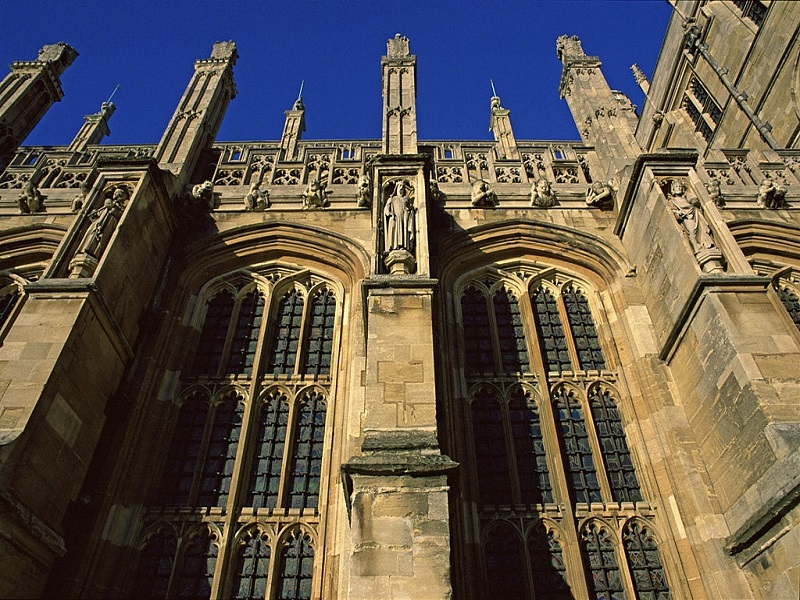
This place is not only a place to live, but also a fortress. Photo: vyctravel.com -
Castle Frontenac (original name: Château Frontenac) is actually a castle-style hotel. The Château Frontenac Hotel was built in 1892. New York architect Bruce Price, designer of Montréal’s Windsor and Viger Stations and inspired by French castles drafted the plans. Head of the Canadian Pacific Railway Company, William Van Horne was responsible for its construction.
The distinguished hotel takes its name after Louis de Buade, Comte de Frontenac. A crucial figure in New France history, Frontenac was the leader of the colony from 1672 to 1682, and again from 1689 to 1698. He has realized problems that it has defended the colony against British and Iroquois attacks.
The Château Frontenac was built next to the Citadel where Frontenac had begun construction in the late 17th century. It contains the Saint-Louis Forts and Châteaux archeological sites. Located on a large cape (Cap Diamant). It protrudes over the St. Lawrence River and runs alongside the celebrated Plains of Abraham historic site where the battle for the conquest of Québec occurred in 1759 during the Seven Years’ War between Great Britain and France.
The center fortress-like tower is based on medieval chateaus located throughout the Loire Valley in France. The asymmetrical profile of the hotel, with steeply pitched roofs, enormous round and polygonal towers and turrets, decorative gables and dormers, and tall chimneys is reminiscent of a Châteauesque. The hotel's exterior is mostly composed of grey stone ashlar, with a steel frame running the length of the structure and Glenboig brick cladding. Mahogany paneling, marble staircases, carved stone, wrought iron, and glass roundels are among the building's interior materials. However, unlike other Châteauesque-styled structures in France, the Château Frontenac did not include Italianate characteristics, instead emphasizing Gothic aspects. The hotel also draws certain elements from the Victorian style of architecture, with rich polychromatic surfaces throughout its exterior.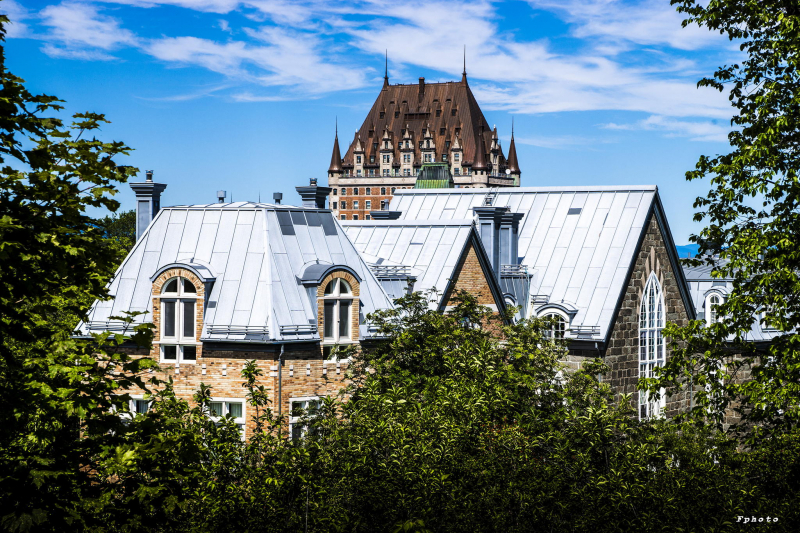
View of Château Frontenac. Photo: thecanadianencyclopedia.ca 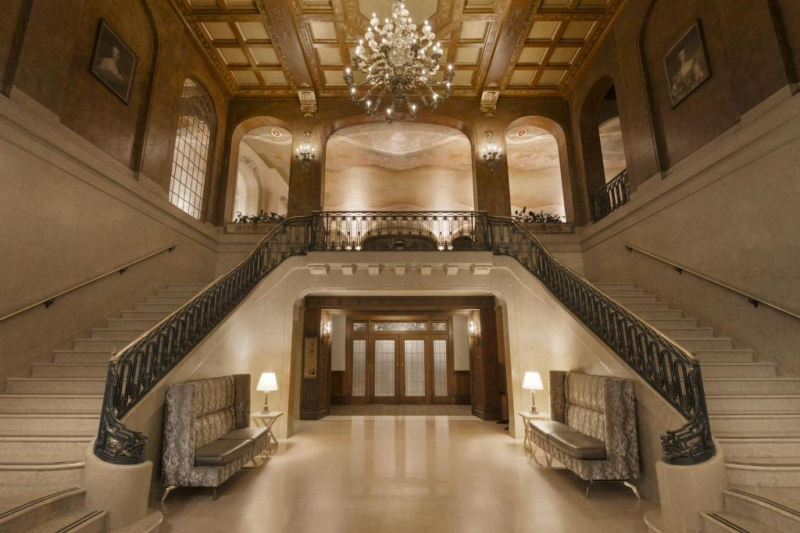
Inside Château Frontenac. Photo: Google -
Prague has begun in the ninth century at the hands of Prince Borivoj. In addition to the castle, he ordered for a palace, three churches, and a monastery to be built, among other landmark buildings. Under Rudolf II, the castle enjoyed its greatest moment of splendor. This was also the last member of the House of Habsburg to use it as their main residence. Although it has occurred many fires and invasions, all of the churches, chapels, halls, and towers have survived. Since 1918, Prague Castle has been the official residence of the presidents of the Czech Republic.
The Guinness Book of Records claims that Prague Castle is the largest ancient castle in the world. Spanning a length of 570 meters, the complex is over seven times the size of a football pitch, while the area containing the castle spans 45 hectares (45.000 m2). Because the building is old, Prague Castle has had to undergo significant restoration work. The first project was carried out by Prince Sobéslav in the twelfth century, followed by more restoration work in the wake of the 1541 fire. The third revamp took place under Empress Maria Theresa (1740–1780) and the castle underwent its final refurbishment in 1920 at the order of President Masaryk.
The castle’s main entrance with salient points is the contrast between the golden Baroque balustrade of the staircase and the simplicity of Plecník’s staircase. Besides, there are replicas of Ferdinand Platzer’s Battle of the Titans sculptures. The first courtyard, where there is the magnificent Matthias Gate (1614), is the oldest Baroque monument in the Czech Republic. The second courtyard has a Baroque fountain in the centre and a well dating from the seventeenth century with a beautiful iron gate. It is also home to the Chapel of the Holy Cross — housed within the former sacristy of St Vitus Cathedral and today home to the gift shop — as well as the Spanish Hall and the Rudolph Gallery, which are reserved for state receptions. The third courtyard of Prague Castle was built by a granite monolith (1928), created in memory of the victims of the First World War, and a replica of the bronze sculpture of the statue of St George. Here, it included the Old Royal Palace (1135), and the Vladislav Hall, where all the presidents of the Czech Republic have been sworn in.
Source: https://www.barcelo.com/guia-turismo/en/czech-republic/praga/things-to-do/prague-castle/
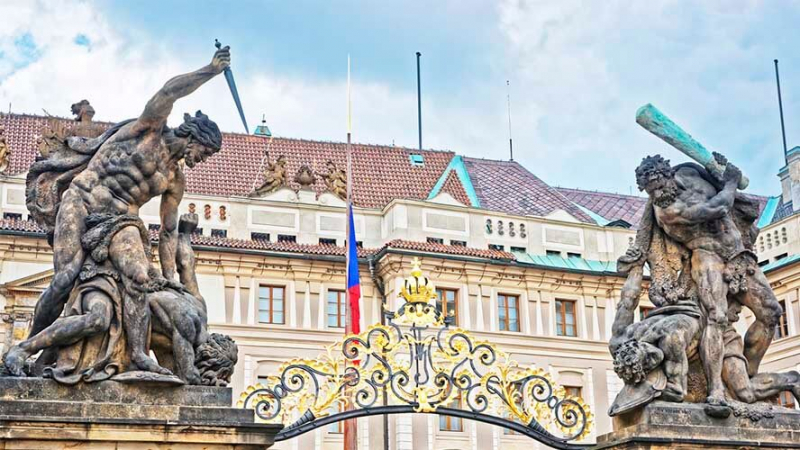
Entrance to the Prague Castle. Photo: barcelo.com 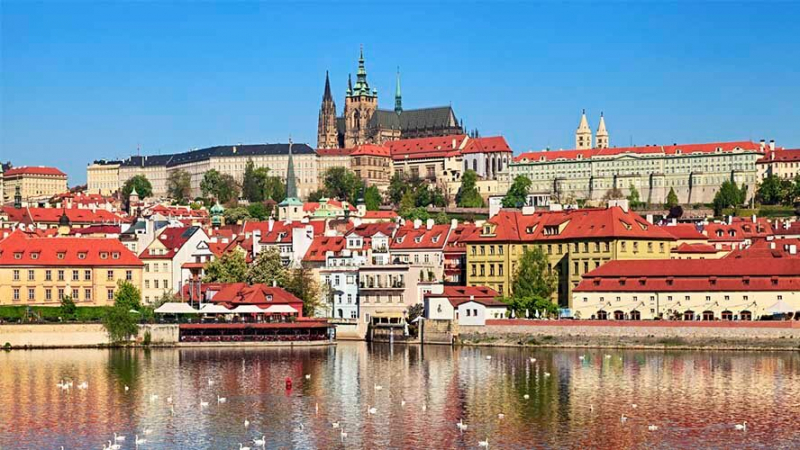
General view of Prague Castle from the Moldova river. Photo: barcelo.com -
Himeji is also known as "White Heron" because the Japanese believe that the image of a noble bird, the white heron, represents the gentleman's noble purity. Himeji Castle is one of Japan's "Three Precious National Citadels (Three Great National Treasures)," along with Matsumoto Castle and Kumamoto Castle. Himeji is the most well-known of the three castles.
Himeji Castle, the largest castle in Japan, was built on top of Himeyama hill 45.6m above sea level. This castle is famous not only for its large main tower but also for its network of 83 buildings with fortified defense systems from the feudal period, complex like a labyrinth. Of these 83 buildings, 74 are designated Important Cultural Properties: 11 corridors, 16 turrets, 15 gates, and 32 earthen walls. The highest walls in the castle complex with a height of 26 m (85 ft). Joining the castle complex is the Koko-en Garden, a Japanese garden created in 1992 to celebrate the 100th anniversary of the city of Himeji.
The Himeji Castle complex is 950 to 1,600 meters long from east to west, and 900 to 1,700 meters long from north to south. The castle complex is 4,200 meters in circumference. It has a total size of 233 hectares (2,330,000 m2).
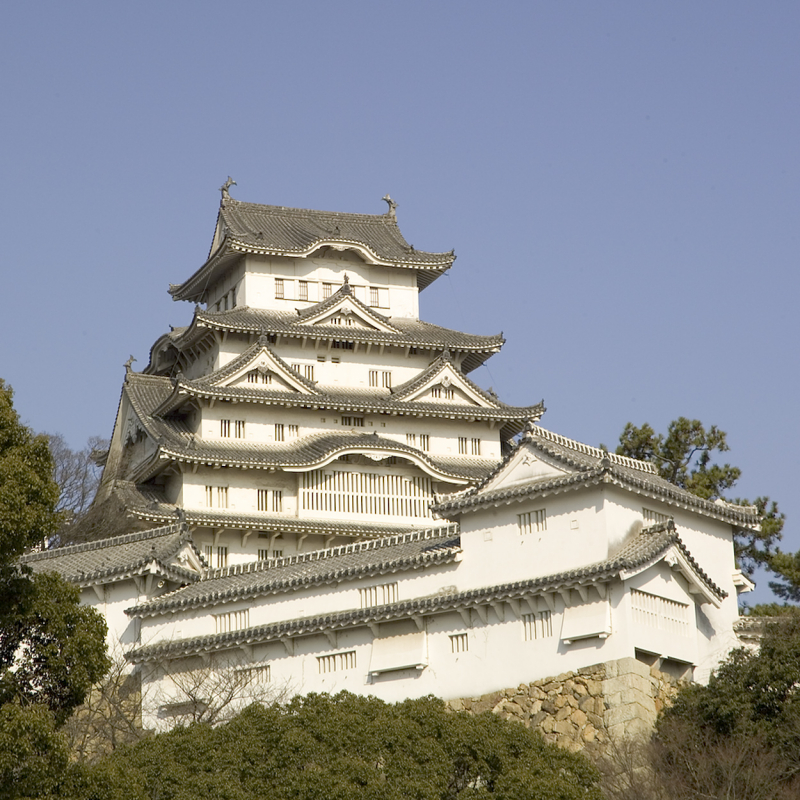
Himeji Castle. Photo: Dulichnhatban 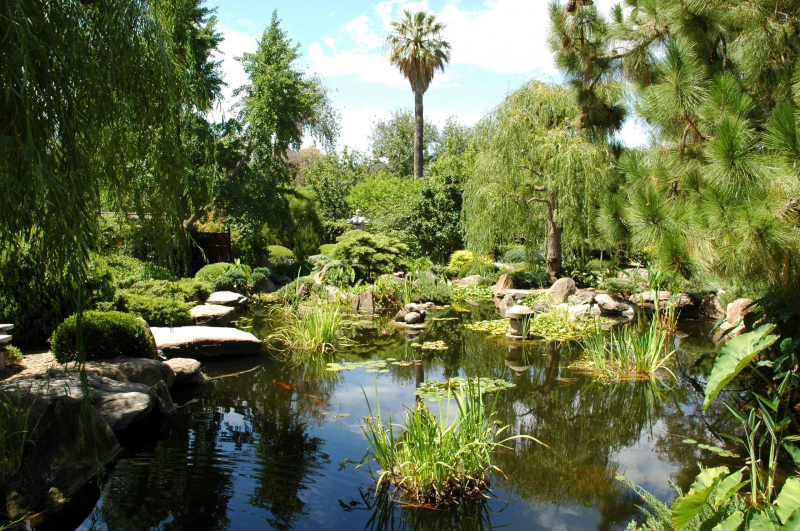
A corner of the Japanese garden in Himeji Castle. Photo: Dulichnhatban -
Edinburgh is located on Castle Rock, a large volcanic rock that rises majestically and impressively in the middle of the city of Edinburgh. Edinburgh Castle is one of the oldest fortified places in Europe with a long history as a royal residence, military garrison, fortress, and prison. Although there are parts of it used in the military, the castle is a world-famous visitor attraction today. It’s also an iconic part of the Old and New Towns of Edinburgh World Heritage Site.
Because of setting upon its mighty rock, Edinburgh Castle’s military potential is clear, so Iron Age people built a hill fort on the rock. The castle has also suffered many sieges. The castle is historically recorded as the most attacked castle in England. During its 1,100-year life, the building has been invaded by at least 26 invasions. During the Wars of Independence, it changed hands many times. In 1314, the Scots retook the castle from the English in a daring night raid led by Thomas Randolph, nephew of Robert the Bruce.
The castle defenses have evolved over hundreds of years. Mons Meg, one of the greatest medieval cannons ever made, was given to King James II in 1457. The Half Moon Battery, built in the aftermath of the Lang Siege of 1573, was armed for 200 years by bronze guns known as the Seven Sisters. Six more guns defend the Argyle Battery, with its open outlook to the north.Source: https://www.edinburghcastle.scot/the-castle/history
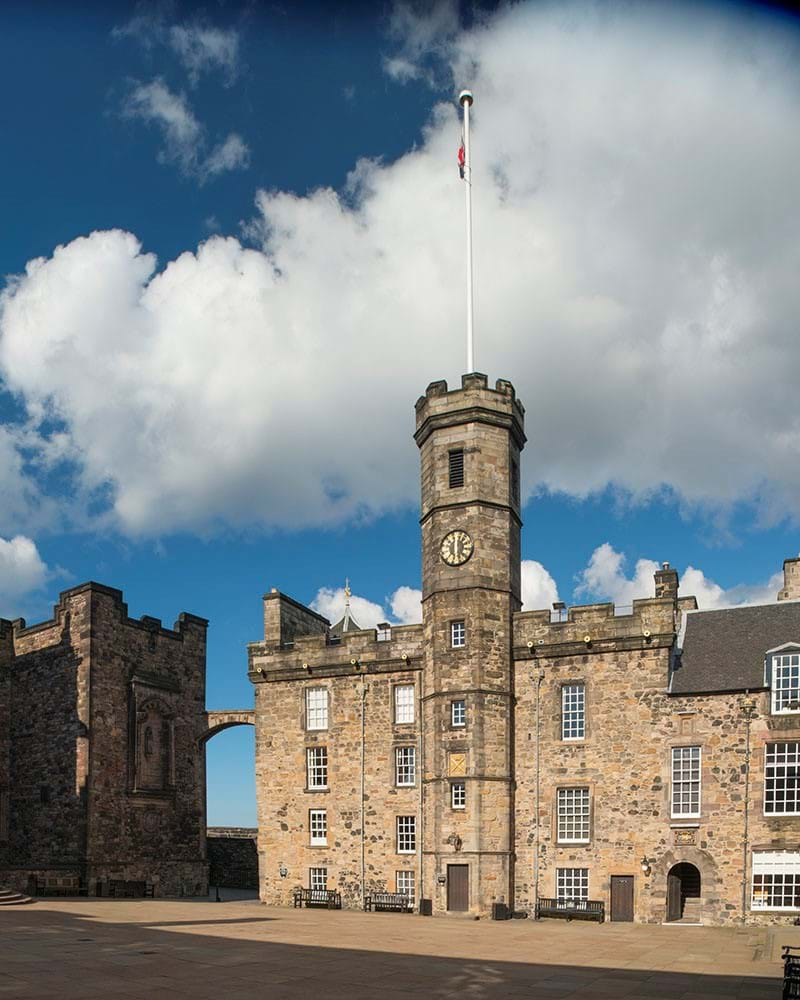
The Royal Palace. Photo: edinburghcastle.scot 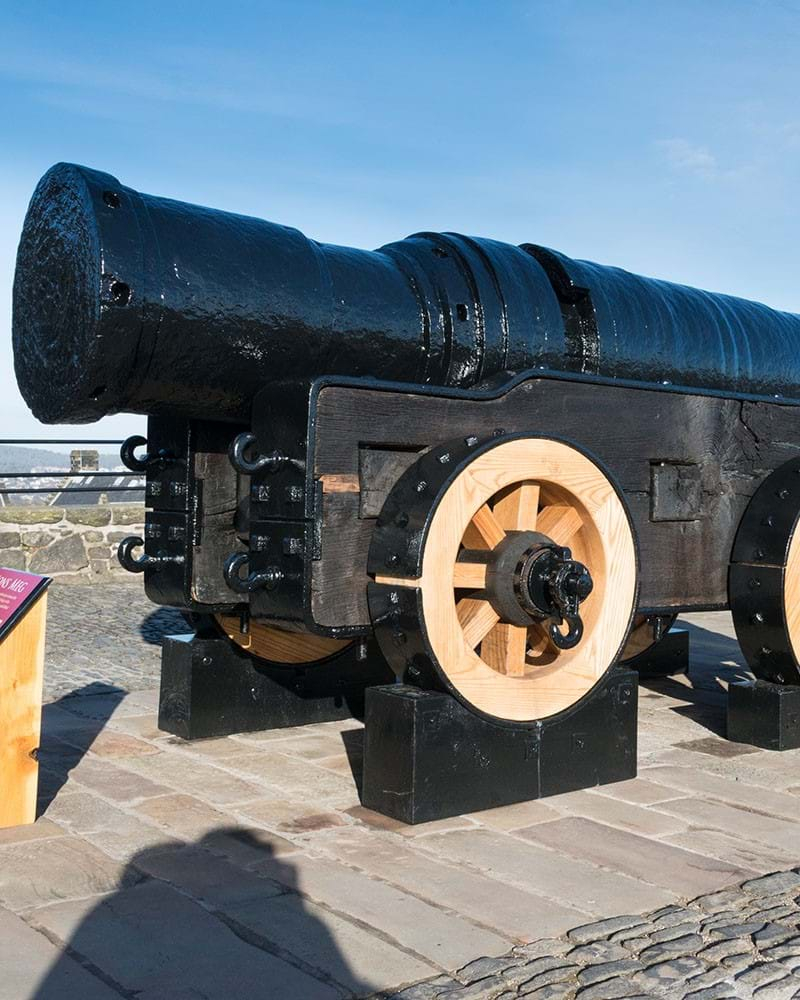
Mons Meg. Photo: edinburghcastle.scot -
The Château de Chambord royal castle at Chambord, Loir-et-Cher, France, built-in 1539, is one of the most recognizable castles in the world for its distinctive French Renaissance architecture, which combines shapes and forms. French medieval tradition with classical Renaissance architecture. This structure, which was never completed, was built by King Francis I of France.
Surrounding the castle is a large, deep green forest 4,440 hectares (44,400 m2) wide, surrounded by a wall up to 31 km long. This is the largest walled forest in Europe. Chambord has a height of 56m with a porch of 156m long, there are 440 luxurious rooms with 365 fireplaces and 356 chimneys with different shapes.
Chambord is the largest castle in the Loire Valley. It was built for the hunting season of Francis I, who maintained his royal residence at the castles of Blois and Amboise. The original design of Chambord Castle was attributed to Domenico da Cortona, although there are some doubts, Leonardo da Vinci may also be involved.
Chambord was significantly altered during the twenty-eight years of its construction (1519–1547), during which time it was supervised on-site by Pierre Nepveu. As the castle neared completion, Francis demonstrated his colossal symbol of wealth and power by hosting his former number one rival, Emperor Charles V, at Chambord. In 1792, against the backdrop of the French Revolution, some of the furniture was sold and the trees were cut down. For a time the building was abandoned, although in the 19th century some efforts were made to restore it. During the Second World War, works of art from the collections of the Louvre and Château de Compiègne were moved to the Château de Chambord.
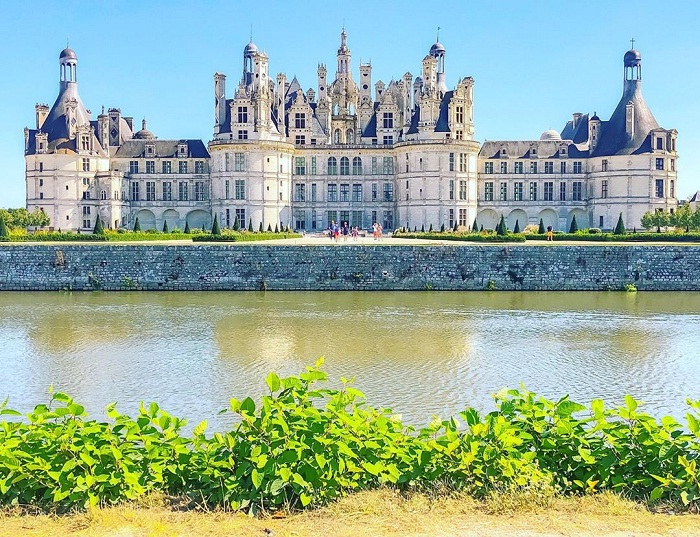
Cahmbord. Photo: @matpyc 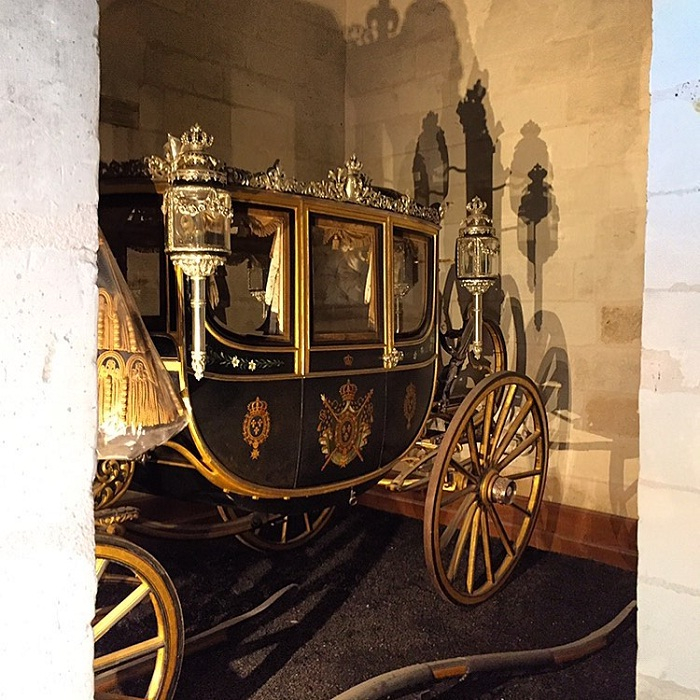
Works of art from the Louvre and Château de Compiègne collections that were transferred during the Second World War. Photo: @chateaudechambord -
Neuschwanstein Castle is located in the village of Schwangau, near the town of Füssen, Bavaria, southern Germany, built-in 1869 at the request of the "crazy king" Ludwig II, a rare strange character in the history of the monarchy of the country. This is the last castle built and lived by King Ludwig II.
Neuschwanstein means "New Stone Swan", derived from a knight character "Swan Knight" in the famous musical by composer and conductor Richard Wagner. The castle is an artistic masterpiece that harmoniously combines many architectures, with Roman arched windows, Gothic pinnacles, Byzantine decoration of gold and marble evoking a poetic and splendid beauty.
Surrounding the castle is a granite wall, inside is a limestone brick wall, creating a solid and sustainable position for the castle against time and the erosion of nature. Inside the castle, the interior is sophisticatedly designed with unique paintings and elegant colors. Because the genius playwright Richard Wagner was also a close friend, King Ludwig had many scenes from his musicals painted on tapestries and murals. The castle was equipped with the most advanced technology of the time such as a battery-operated servant bell, central heating system, water heater, and automatic flushing toilet.
This castle is the model for the castles in Disneyland and has appeared in many fairy tales because, in the early morning, the thin mist surrounds the castle, if looking back from far can only see the pointed watchtowers hidden in the clouds. Standing on the balcony of the castle, looking out into the distance to enjoy the panoramic view of the Schwangau steppe of the majestic Bavarian region, Alpine and Schwansee lakes lie side by side. In the distance are the Tyrolean Mountains that divide Germany and Austria.
After 17 years of construction until the death of King Lugwig II, he only stayed in the castle for only 172 days. After the king's death, the square tower and knight's house were completed in a simpler way, and the chapel was not built as originally planned. King Ludwig II was known as a "crazy king", he would rather destroy the castle than let the common people visit because that would lose its legendary character. But just six weeks after his death, the castle opened to visitors. Today, tourists only visit mainly 6 private rooms of the king and 2 main halls.
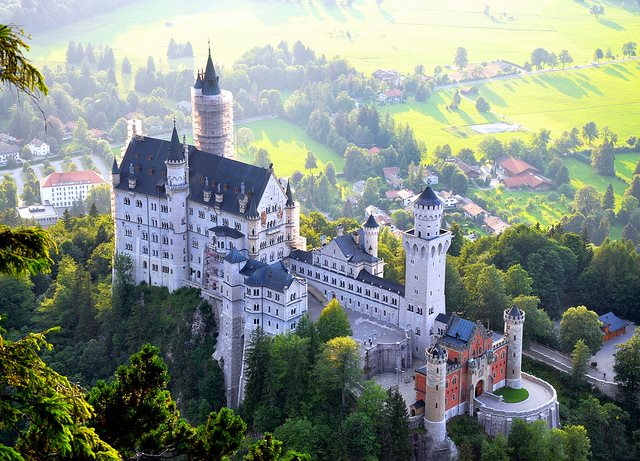
Neuschwanstein Castle. Photo: thuthuatdulich 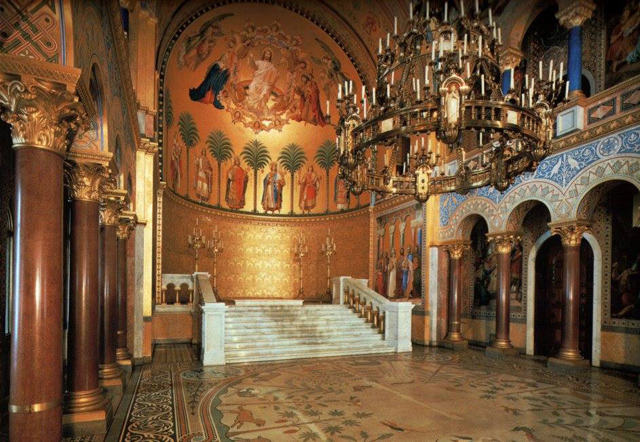
Inside the castle, the interior is sophisticatedly designed with unique paintings and elegant colors. Photo: thuthuatdulich -
Krak des Chevaliers ("Fortress of the Kurds") is a Crusader castle in Syria and one of the most important preserved medieval castles in the world. The site was first inhabited in the 11th century by a Kurdish settlement as a garrison under the Mirdasid dynasty. In 1142, the castle became a gift from Raymond II of the County of Tripoli to the Knights Salvation. The castle remained in their possession until it was abandoned in 1271. The castle is also known as Crac de l'Ospital, the name Krak des Chevaliers which appeared only in the 19th century.
After an earthquake damaged the castle, the Knights Hospitaller began rebuilding the castle in the 1140s and completed it in 1170 when an earthquake destroyed the castle. The Order controlled a number of castles along the border of the County of Tripoli, a state established after the First Crusade. Krak des Chevaliers is one of the most important castles and served as an administrative center as well as a military base. After a second construction in the 13th century, Krak des Chevaliers took the form of a concentric castle. During this time, the outer walls were built and brought the castle to its present shape. The first half of the 13th century is described as the "golden age" of Krak des Chevaliers. At its height, Krak des Chevaliers had a garrison of about 2,000 men. Such a garrison allowed Order knights to collect tribute around a large area. From the 1250s this acquisition became worse and worse, and in 1271, Mamluk's sultan Baybars I captured the castle after a 36-day siege believed to have stemmed from a forged letter surrender of the Grand Leader.
Interest in Crusader castles in the 19th century led to the investigation of Krak des Chevaliers, and architectural plans were drawn up. In the late 19th or early 20th century, a settlement was established within the castle, causing its structures to be damaged. About 500 residents moved into the castle in 1933, and it was given to the French Alawite State, which subsequently undertook a program of reclamation and restoration. When Syria declared independence in 1946, control belonged to the new nation.
Since 2006, the castle Krak des Chevaliers has been designated a UNESCO World Heritage Site. It was partially damaged during the Syrian civil war by shelling and was recaptured by the Syrian government in 2014. Since then, reconstruction and conservation work on the area has begun.
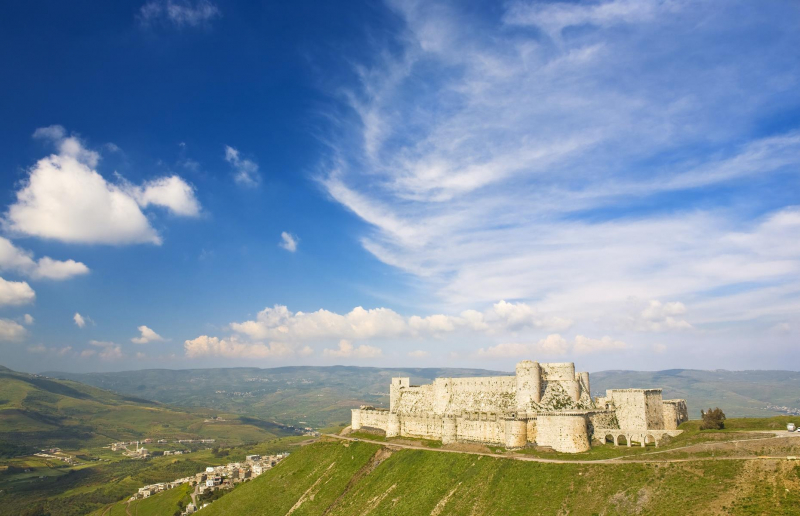
Krak des Chevaliers. Photo: toquoc.mediacdn.vn 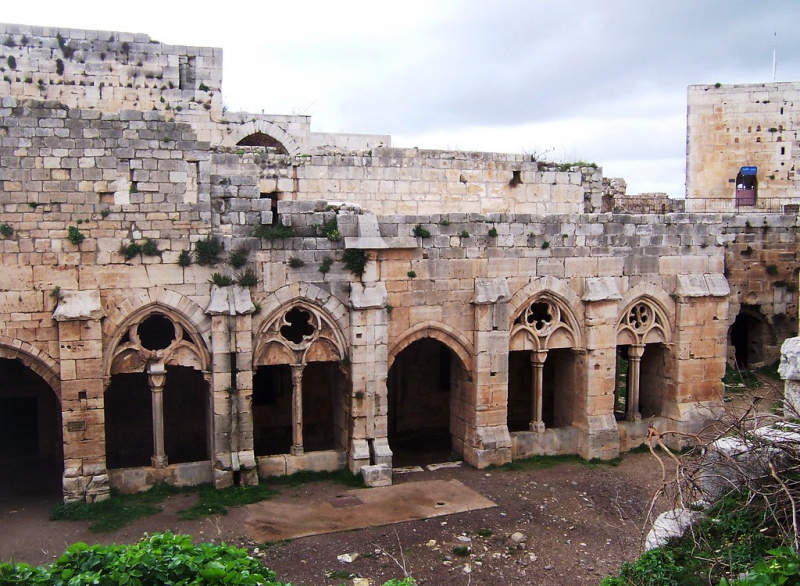
Krak des Chevaliers. Photo: staticflickr -
Bran Castle was built in 1382 as a fortress on the border of Transylvania. Count Vlad Tepes defended here for 2 months against the Ottomans, Vlad is said to have slaughtered, drank blood, and brutally tortured about 40,000-100,000 prisoners in his lifetime. Bram Stoker's character Dracula was inspired by Count Vlad Tepes himself, turning Bran Castle into "Dracula Castle".
Bran Castle is built on a rock block located at an altitude of 760m above sea level with about 60 rooms. The isolated location surrounded by mountains, forests, and valleys gives Bran a mysterious and magical appearance that is true to the name. Bran's architecture is mostly preserved, with red and pink tiled roofs, white-gray lime walls, watchtowers, stone walkways or an ancient well with a depth of 20m dug through the hard rock still preserved in its original state.
Queen Marie - the last queen of Romania, has a special love and very often uses Bran Castle as a personal retreat. In 1948, the communist regime recovered and turned Bran into a museum, a very attractive destination to this day.
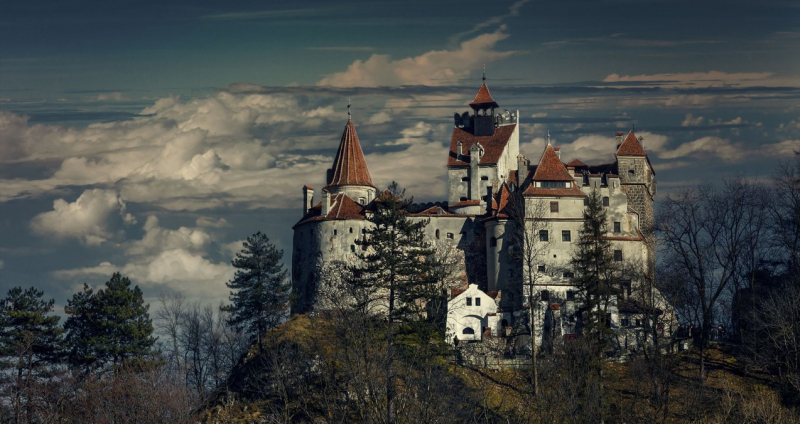
Bran Castle. Photo: khamphabonphuong 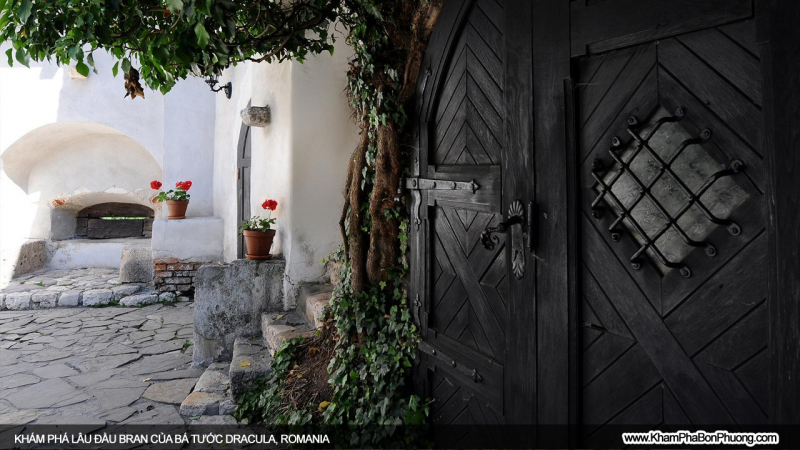
the old glossy black wooden door under the green foliage, mossy stone steps, small flower pots blooming with beautiful petals. Photo: khamphabonphuong












